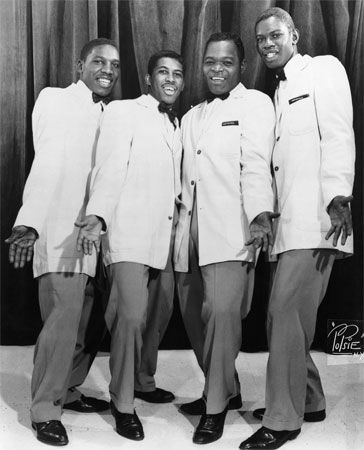the Drifters
- Awards And Honors:
- Rock and Roll Hall of Fame and Museum (1988)
- Date:
- 1953 - present
- Related People:
- Clyde McPhatter
the Drifters, American rhythm-and-blues vocal group that produced a series of chart-topping hits from the early 1950s to the mid-1960s. The Drifters were actually two groups—one built around lead singer Clyde McPhatter, the other an entirely different group that took the name Drifters, to which manager George Treadwell held the copyright, after he dismissed the original contingent. The principal members of the first incarnation were:
- Clyde McPhatter (born November 15, 1932, Durham, North Carolina, U.S.—died June 13, 1972, New York City, New York)
- Billy Pinckney (also spelled Billy Pinkney; born August 15, 1925, Sumter, South Carolina—died July 4, 2007, Daytona Beach, Florida)
- Andrew Thrasher (born October 14, 1933, Wetumpka, Alabama—died August 7, 1978)
- Gerhart Thrasher (born December 3, 1928?, Wetumpka—died November, 12, 1977)
- “Little David” Baughan (born June 28, 1937, New York City—died January 1, 1970, New York City)
Principal members of the second incarnation included:
- Ben E. King (original name Benjamin Earl Nelson; born September 28, 1938, Henderson, North Carolina—died April 30, 2015, Hackensack, New Jersey)
- Dock Green (born November 8, 1934, Harlem, New York—died March 1989, New York City)
- Elsbeary Hobbs (born January 17, 1936, Manhattan, New York—died May 31, 1996, Manhattan)
- Rudy Lewis (born August 23, 1936, Philadelphia, Pennsylvania—died May 20, 1964, Harlem, New York)
- Johnny Moore
The Drifters were formed in 1953 at the behest of Atlantic Records cofounder Ahmet Ertegun, who approached McPhatter when the popular vocalist was dropped from Billy Ward and the Dominoes. After serving in the U.S. Army, McPhatter left the Drifters in 1955 to pursue a solo career—but not before the group had reached number one on the Billboard rhythm-and-blues charts with “Money Honey” (1953) and scored several other hits, including “White Christmas” (1954).
Three lead singers later, in 1959, Treadwell replaced the entire group with another ensemble, the Five Crowns, led by King. Still recording for Atlantic, now under the guidance of writer-producers Jerry Leiber and Mike Stoller, the Drifters cracked the top 10 of the pop singles chart in 1959 with “There Goes My Baby” (remembered for its innovative use of strings and Latin rhythms) and took “Save the Last Dance for Me” (1960) to number one.
King, too, left and became a successful soloist, scoring hits with “Spanish Harlem” (1960) and “Stand by Me” (1961). However, the Drifters continued their string of hits, benefiting from the Brill Building-style songwriting prowess of teams such as Carole King and Gerry Goffin and Mort Shuman and Doc Pomus. Lewis sang lead on “Up on the Roof” (1962) and “On Broadway” (1963), while Moore took the lead on “Under the Boardwalk” (1964) after Lewis died on the eve of its recording. (His death at age 27 made him an early member of the so-called 27 Club.)
Although the group’s popularity waned in the mid-1960s, a changing membership carried the Drifters’ gospel-tinged sound into the early 21st century. The Drifters were inducted into the Rock and Roll Hall of Fame in 1988.




